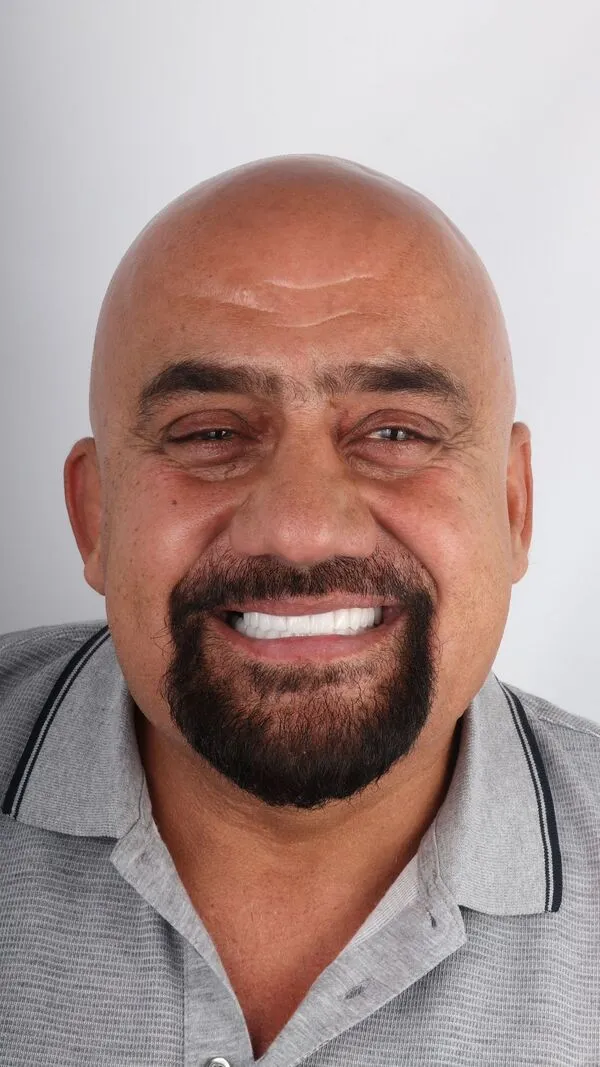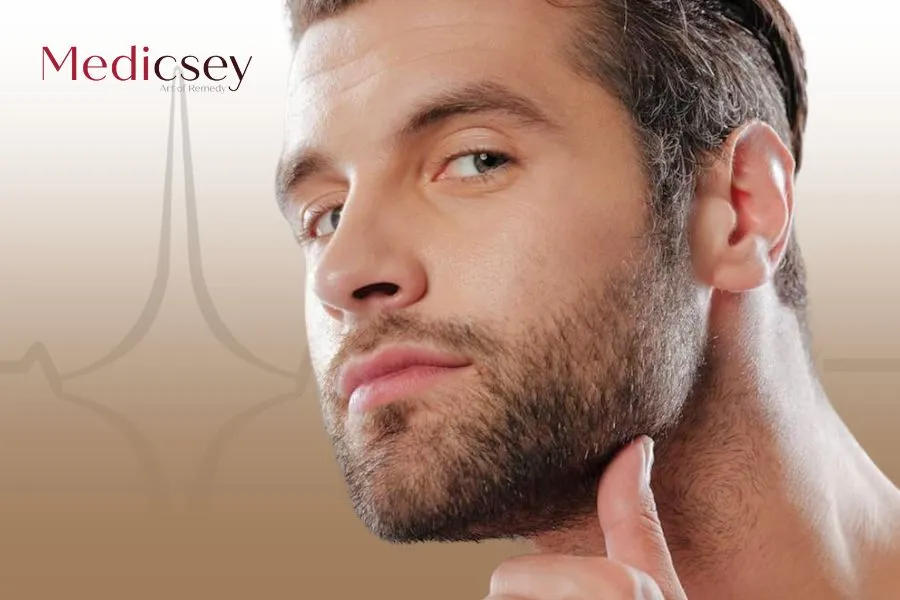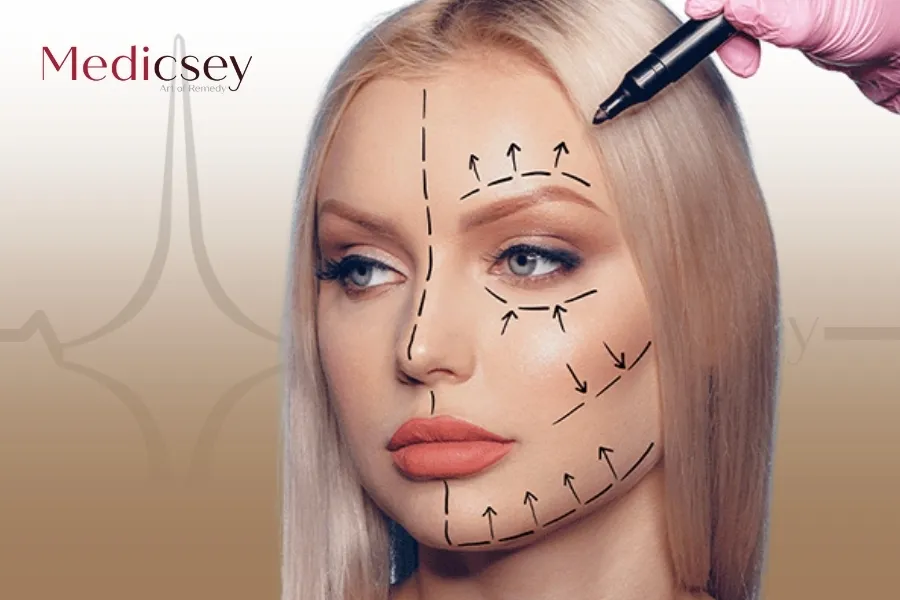Table of Contents
- What is the beard transplant in Syria?
- Who needs a beard transplant in Syria?
- What is the beard hair transplantation procedure?
- Things to consider before undergoing a beard transplant in Syria
- Follicular unit extraction FUE
- How many sessions will I need?
- Beard transplant in Syria
- Rest and recovery
- What is the Beard transplant cost in Syria?
- Complementary treatment after beard hair transplantation
- Expert opinion on chin implants in Syria
- Frequently Asked Questions
- What are the long-term harms of hair transplantation?
- Does the transplanted hair last a lifetime?
- Does the face swell after hair transplantation?
Beards are considered a source of attraction and beauty for men, especially in Arab countries, where their presence increases a man's prestige and character. What if our young men lost their beards?
Fortunately, with scientific advancements, there's always a solution, dear reader. Beard transplant in Syria is a revolutionary way to restore your beard hair, giving you back your self-confidence, strength and a weapon to carry on with your life. What is this procedure and how is it performed at our Medicsey clinic? Follow along in this article as we'll answer all your questions!
What is the beard transplant in Syria?
When people search for the term "beard transplant in Syria," they have two meanings in mind: either transferring hair to the beard to make it appear thicker or wider, or transferring hair from the beard to other parts of the head and body.
The first case is hair transplantation into the beard to make it appear thicker, and it can involve either using beard hair as a source (usually from under the chin where the beard is not of great aesthetic importance), or using scalp hair transplanted into the beard.
The second case is using beard hair (usually from the area under the chin) to transplant it to areas other than the beard, such as the scalp, etc.
Who needs a beard transplant in Syria?
For the candidate who simply desires a fuller beard, the procedure should be determined based on how full the beard is desired, for example, a full lumberjack-like beard or a low profile beard where the hair extends above the jawline for a short distance.
Other reasons that may prompt a person to undergo a beard transplant include hair loss due to scarring or injury, and the desire to transplant beard hair into areas that are otherwise hairless.
A person uses beard hair as a source for transplantation, for example the scalp when the donor stock has been depleted from multiple previous transplants, and the beard is used as a salvage source.
Age should also not be a major concern for a beard transplant candidate, as beard hair is resistant to the effects of dihydrotestosterone.
What is the beard hair transplantation procedure?
If beard follicles are used as the source for transplantation, the only safe method for extracting beard hair is the follicular unit extraction (FUE) technique, which involves extracting hairs through punch excision rather than a strip procedure. If the follicles are to be transplanted into the beard, they can be extracted from the scalp either through the strip procedure, formerly known as FUT (follicular unit transplantation), or what is now known as linear strip excision (LSE), or through the follicular unit extraction (FUE) technique, which is the latest, least painful, and most successful method of extracting hair follicles, making it our first choice at Medicsey Hair Clinic in Syria.
Things to consider before undergoing a beard transplant in Syria
If the beard is used as a donor area, it's important to ensure that the grafts match the transplant site. For example, if the beard hairs are curly, dark, and reddish, and the scalp hairs to be transplanted are soft, straight, and blonde, the result won't look ideal! If there's a mismatch between the donor and recipient areas, the result may appear natural even if the beard hairs are used as fillers between other transplanted hairs.
Another thing to consider is whether there are enough beard follicles in the donor area to transplant them to other areas where the intended transplant sites will be.
If the beard is both the donor and recipient area, the color and density match will be perfect! A beard transplant provides an unparalleled match between the donor and recipient areas because they are identical, but the donor area is often located behind the scalp.
If scalp hair is to be used to fill in the beard, the above-mentioned match of donor hair to recipient hair must be close enough to produce a natural-looking transplant.
In addition, the patient's scalp hair must be considered safe and effective for transplantation: for example, if someone suffers from male pattern baldness, taking hair from the scalp has two major problems, if not more:
1) Scalp hair removal is not scar-free, which means it will leave white dots when the patient decides to shave his head.
2) It may be unwise to remove valuable scalp hair that may be needed for scalp transplantation and this is where a skilled surgeon comes in who makes preferences that suit the patient's condition and appearance.
Follicular unit extraction FUE
In general, the donor area must be shaved before the follicles are removed, but not the recipient area. For beard hair harvesting, the only method is follicular unit extraction (FUE), where the hairs are harvested using a rotating punch device, either manual or automated but always handheld. These automated devices rotate automatically to facilitate tissue entry but must still be guided through the skin by the skilled hand of a surgeon like MedicseyY.
Many surgeons do not perform beard follicle extraction due to the increased technical difficulty of the beard compared to the scalp. Beard hairs change direction almost constantly throughout the beard area, making extraction more difficult. This is what distinguishes our clinic's surgeons, who can skillfully extract follicles from any area!
How many sessions will I need?
Any type of hair transplant involves transplanting follicles that require healthy blood flow to grow, so there is no guarantee of 100% success after each session, regardless of the surgeon you choose. The number of grafts required may range from a few hundred to over 800 grafts for the procedure. Limited donor hair may also reduce the density of the result. A qualified surgeon will discuss these limitations with you, as well as the expected number of sessions required to achieve your aesthetic goals.
Beard transplant in Syria
After extracting hair follicles using the FUE technique, the surgeon usually determines the appropriate technique to use for the transplant. There are two main methods for transplanting follicles:
- In the Sapphire technique for hair transplantation, Medicsey surgeons use a sapphire blade to open the holes into which the follicles will be implanted in the recipient area.
- DHI (direct hair transplantation) technique, where the surgeon implants the follicles directly into the recipient area using a tool called a Choi pen, is considered one of the newest and most efficient methods.
Rest and recovery
Most hair transplant procedures typically do not involve much pain, bruising, swelling, or recovery time. However, every patient is different, and recovery times vary between practicing surgeons.
- Your surgeon will instruct you when you can shave the donor area and when you can shave the recipient area. These instructions vary from surgeon to surgeon.
- Whether bandages, ointments, or other treatments are necessary again depends on the surgeon's preference.
- There will usually be scabs on the areas where the hair was taken from on the scalp and beard, and there will also be visible scabs on the recipient area, where the hair was transplanted.
- You should speak with your surgeon to discuss when the surgeon believes it is ideal to begin removing existing scabs (without ever removing them) without disturbing the implanted grafts.
But the good news is that once you fully recover after the transplant, these beard hairs will become permanent and can last a lifetime.
What is the Beard transplant cost in Syria?
The cost of a beard transplant varies greatly and depends on many factors, including, but not limited to, the surgeon performing the procedure, the number of grafts to be transplanted, the type of procedure and technique used, and many other factors.
|
The process |
Beard transplant cost |
|
Beard transplant in Syria |
$1000 regardless of the number of follicles |
Complementary treatment after beard hair transplantation
To increase beard density, minoxidil is the only medication that helps improve beard density. You can use a 5% formula or try a higher concentration. The problem with minoxidil is that its results are unpredictable, and are usually less than those of a hair transplant. It must be maintained, otherwise the results will fade and eventually return to normal. Oral minoxidil can also be used for beard growth. It is best to use it after a transplant to ensure optimal results.
Expert opinion on chin implants in Syria
Beard hair is an excellent and powerful source of hair suitable for transplantation due to its high survival rate and rapid growth. One of the advantages of beard hair is that when it is used as a donor area, it rarely shows noticeable scarring or hypopigmentation (loss of skin color) even in people with darker skin, unlike the scalp area, which can show hypopigmentation in all races.
Beard transplantation offers an unparalleled match in quality, as the donor and recipient areas are from the same individual. However, the main limitation of beard transplantation is the lack of beard hair, which many men may have in the donor area, i.e., under the chin. Scalp and beard transplants suffer from scalp hair depletion and other limitations mentioned above, including ensuring that the calibre and colour match the beard area well.
Frequently Asked Questions
What are the long-term harms of hair transplantation?
Long-term risks of hair transplantation include hair loss or irregular hair growth, but finding an experienced, qualified doctor will protect you from these problems. There is also loss of sensation or numbness in the transplanted area.
Does the transplanted hair last a lifetime?
Yes, the transplanted hair will last a lifetime if you choose a suitable, highly experienced doctor, such as Medicsey Clinic, and take care of your hair according to the surgeon's recommendations.
Does the face swell after hair transplantation?
It varies depending on each patient's condition. Some patients experience facial swelling, while others do not. Therefore, you must discuss this with your doctor. You can use cold compresses if swelling occurs.
At the end of our article on Beard transplant in Syria, we hope we've provided a comprehensive overview of the procedure, including its techniques, preparation, and recovery period. You can book a free consultation via WhatsApp with the Medicsey Clinic team and inquire about anything you may have in mind.
Read more: Eyebrow transplant in Syria









.webp)


.webp)


.webp)